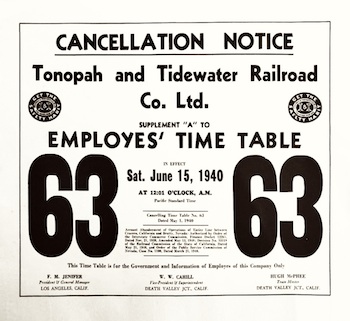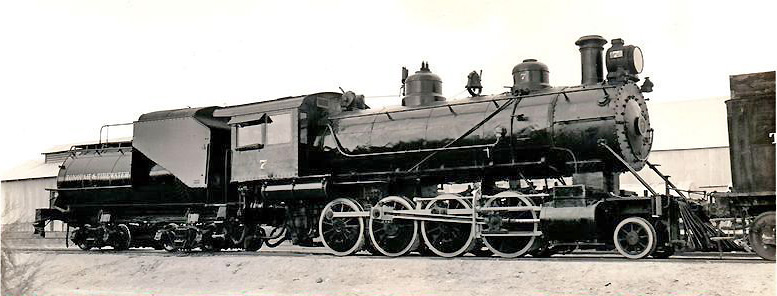|
After limping through the Depression, Tonopah & Tidewater essentially gave up in 1940, but with a large asterisk. Wx4 friend Dave Sprau has some direct professinal knowledege of its arguably shifty effort to exit the business, and how the one page employee timetable seen here was part of the master plan. Now retired, Dave has a long history as a dispatcher and union rep, among other jobs, beginning with NP as a telegrapher in 1960. He later went to GN, then BN where he worked former SP&S and Pacific Coast RR territories. He even served as a short line superintendent for a short time. |
|||
| Dave relates:
I have a fair idea of why Wm. Washington Cahill, Supt. of the T&T, thought it would be necessary to issue such a thing. As the Milwaukee and other railroad companies later have taught us, all you actually need to do is turn off the lights and walk away from the property, and it is "end of story." However, in this particular case, it was closely related to the fact that the desired cessation of operation was at the very doorstep of WWII and due to the possible necessity of needing borax, asbestos, carbonates, and other minerals from the closed-down mines in the area, the U.S. Government (via the ICC) was balking at letting Pacific Coast Borax, owner of the railroad, abandon it. So a ruse was invented: Don't abandon the railroad, merely "Cease Operations," leaving it intact and "ready to go" upon momentary notice. This included maintaining telegraph lines essential to Western Union for communicating with places like Beatty, NV and Baker, CA and everyplace in between, and keeping an operator in place for awhile at at least two stations, death Valley Jct. and either Shoshone or Beatty, along with the rail and ties. Make it clear they are only ceasing "Operation" of the line. |

Click on the image for a PDF from our Historical Maps & Timetables section. |
||
|
And that is just what they did. At least for a couple of years. This also included keeping the roundhouse at Death Valley Jct. cleaned up and the cold engines ready-to-go, patrolling the track weekly, and keeping all the water tanks filled for locomotives that would never arrive. About two years into this charade, it was decided that Hitler and Hirohito could be defeated without any help from the T&T, and telephones came to the little towns also, enabling the line to be torn up. But the actual ICC authority for abandonment didn't issue until 1945, about three years after it was all gone. How do I know this? Mainly from reading a lot of Death Valley History, but also from personally knowing one of the T&T Dispatchers, David Lowe, who later went to the ATSF at San Bernardino and the UP at Las Vegas as a dispatcher. David or "Deke" as he was called, and his wife who was head Librarian at UNLV in Las Vegas, both told me lots of T&T stories. He was a good buddy of Bob McCoy, who after being an operator on Deke's territory at Kelso Ca for the SPLA&SL (UPRR), became a BN Dispatcher at Spokane and Seattle - as were two of Bob's sons. // DTS
Looking much as she appeared when she left Baldwin in 1907, T&T #7 sits all dolled up with nowhere to go at Death Valley Junction in November, 1940, a few months after operations ceased. - photo by M. R. M. Kelley |
|||
